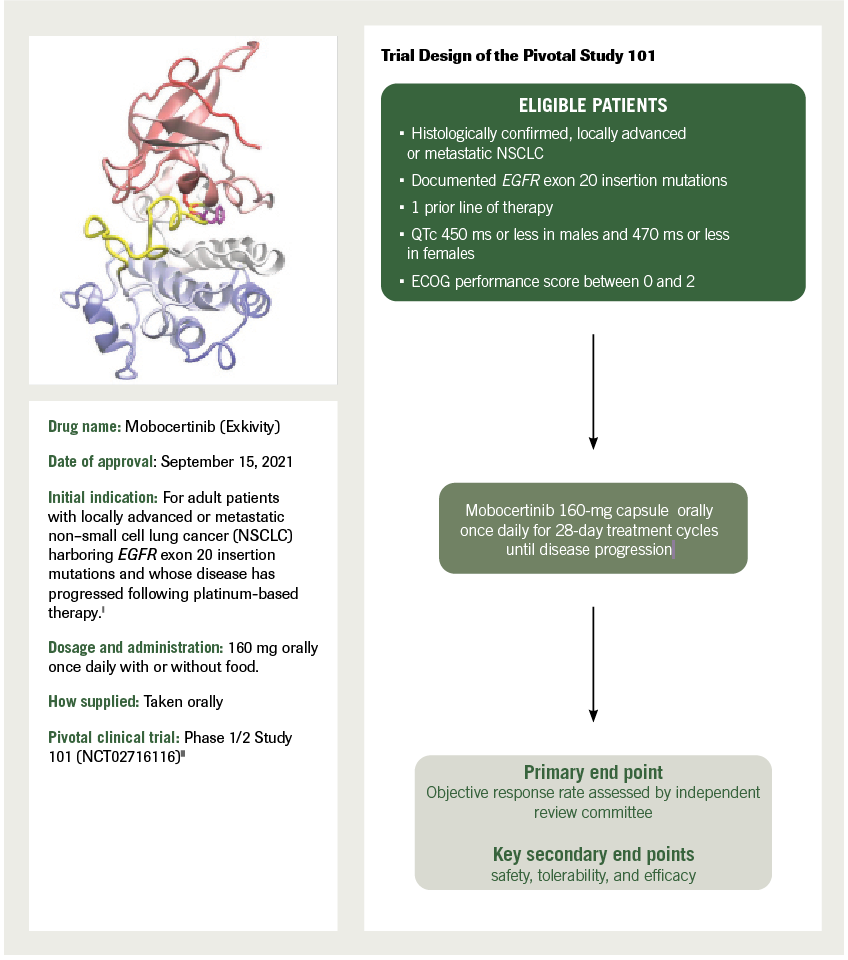Expert Commentary on the Product Profile of Mobocertinib
In an interview with ONCOLOGY®, Megan May, PharmD, BCOP, offers a comprehensive review of real-world treatment considerations of mobocertinib as therapy for patients with lung cancer.
Megan May, PharmD, BCOP
Clinical Oncology Pharmacy Specialist Baptist Health
Lexington, KY

Oncology®: Describe the mechanism of action of mobocertinib?
May: Mobocertinib is a small molecule oral EGFR tyrosine kinase inhibitor [TKI], and it was designed specifically to target EGFR exon 20 insertion mutations. It binds to and inhibits EGFR exon 20 insertion mutations at a lower concentration than the wild-type EGFR. It also has inhibitory activity on other EGFR family members, such as HER2 and HER4. EGFR exon 20 insertion mutations occur in about 2% of all patients with NSCLC, and they’re more common in patients with adenocarcinoma, Asian American [patients], and African American [patients]. Mobocertinib is indicated in [patients with] locally advanced or metastatic NSCLC with the EGFR exon 20 insertion mutation whose disease have progressed on or after a platinum-based chemotherapy.
Q: Describe the toxicity profile of mobocertinib. Have any adverse events become more apparent in the real-world setting?
May: There is a black box warning for QTc prolongation that everyone needs to be aware of. In the trial, 11% of patients had a 60-ms increase in their QTc from baseline. For example, a patient has a QT change from 350 to 410 ms, which is a huge jump. The average overall increase was 23 ms. If a patient’s QTc at baseline was above 470 ms, they were excluded from the study. When we are starting a patient on this medication, we need to make sure we’re monitoring QTc and electrolytes at baseline and periodically throughout treatment. In the study, they checked QTc at month 4 and month 12. For my patients, we’re going to recommend quarterly monitoring for the QTc prolongation.
Other precautions to be aware of [are that] about 4% of patients in this study developed interstitial lung disease or pneumonitis. We do need to make
patients aware of the risk of this and advise patients to report any signs and symptoms to the provider. Cardiac toxicity was also seen in 2.7% of patients. This includes decreased ejection fraction, cardiomyopathy, and congestive heart failure. The package insert says [to monitor this] at baseline and during treatment. In practice, we are going to recommend monitoring quarterly. A reason that we see the cardiotoxicity is because the mobocertinib is also inhibiting those HER kinases.
This is an EGFR TKI, so we’re going to also think of those classic EGFR [adverse] effects [AEs] that we’re aware of. By far the most common AE was diarrhea, and this was seen in about 92% of patients in the study. Common AEs were rash, stomatitis, vomiting, and nausea.
As I previously mentioned, 92% of patients had diarrhea of all grades in the study and 21% of them had grade 3 or higher diarrhea. The median time of
onset of diarrhea was about 5 days, but it also occurred in as little as 24 hours after taking the first dose. This is usually manageable with dose adjustments and proper treatment. Hopefully these patients will be on treatment long-term, so we want to make sure that we do not have to dose adjust if we don’t have to. I advise patients during education to have an antidiarrheal medicine like loperamide on hand before they even start treatment. As soon as they have any diarrhea, they need to start taking that loperamide, increase their fluid intake, and report their symptoms to us.
Depending on the severity of the diarrhea, though, you might have to withhold, reduce, or permanently discontinue the mobocertinib. [Investigators stated] in the protocol to be more proactive with the antidiarrheal medication, so as soon as a patient had grade 1 diarrhea, the protocol did recommend going ahead and using an antidiarrheal medication.
Q: Are dosing modifications common with this agent?
May: There are some dose adjustments that are needed with some toxicities. I already mentioned diarrhea, and if you have grade 2 or higher diarrhea, you will need to reduce the dose. If the ejection fraction decreases, or they have a QTc interval prolongation greater than 481 ms, you will need to do a dose adjustment. The FDA-approved dose is 160 mg once a day; the first dose reduction is to 120 mg a day, the next reduction is 80 mg a day, and then you must permanently discontinue if the patient cannot tolerate the toxicities with that reduced dose. One other thing to mention with this is if a patient does develop heart failure or interstitial lung disease, you want to permanently discontinue treatment. You would not want to dose reduce for that.
Q: What are the major drug interactions clinicians should be aware of, if any?
May: Mobocertinib is a CYP3A substrate, so we do need to make sure patients are avoiding grapefruit and grapefruit juice. You also must avoid use with strong or moderate CYP3A inhibitors. If you must use a CYP3A inhibitor in combination, you do need to reduce the dose by 50% and monitor that QTc more frequently. Another issue we see in clinic is since patients are staying on these drugs long-term, you want to make sure you’re evaluating their current medications at every visit. You might need to adjust the dose depending on if they start a new agent or if they’re stopping an agent that they’ve been on previously. We want to make sure they can stay at the highest dose possible throughout treatment to have the best efficacy.
Q: Have barriers to administration emerged since this agent’s approval?
May:The biggest issue logistically for this drug is getting insurance coverage. Like most of our oral TKIs, there is a very high price tag for mobocertinib. There is a co-pay assistance program available for commercially insured patients, and the patient can pay as little as $0 per script if they can enroll in that program. If a patient has government insurance, then in my clinic we look for grant funding to assist the patient if they have a high co-pay amount. If a patient is uninsured or under insured, this manufacturer does have a patient assistance program that [may] hopefully get the medication at no charge.
Another unique thing is the manufacturer has a program called the Here2Assist Rapid Start program.3 If your patient is trying to start the medication and you’ve had more than a 5-day delay, the patient can get a 1-month supply at no cost from the manufacturer to help you obtain the medication for future use. The manufacturer has contracted with Biologics and Onco360 as their in-network specialty pharmacies. If you are sending this prescription to an outside pharmacy, make sure you’re sending it to one of those 2 specialty pharmacies so you don’t delay getting the drug to the patient.
Q: Is there anything else you want to add?
May: One thing we do need to be aware of is that the indication for mobocertinib is approved under accelerated approval.4 [The approval] was based on the overall response rate and duration of response data. To continue this approval, it is contingent upon verification of clinical benefit and confirmatory trials. There is an ongoing study looking at this, and it’s in patients in a first-line setting. These patients have not had prior systemic therapy, and they’re randomizing the patients to mobocertinib compared with standard-of-care chemotherapy.
Trial Design of the Pivotal Study 101

References
1. Mobocertinib. Prescribing information. Takeda; 2021. Accessed January 18, 2022. https://bit.ly/3qC7UmQ
2. Zhou C, Ramalingam SS, Kim TM, et al. Treatment outcomes and safety of mobocertinib in platinum-pretreated patients with EGFR exon 20 insertion-positive metastatic non-small cell lung cancer: a phase 1/2 open-label nonrandomized clinical trial. JAMA Oncol. 2021;7(12):e214761. doi:10.1001/jamaoncol.2021.4761
3. Takeda Oncology Here2Assist. Here2Assist.com. Accessed January 19, 2022. https://www.here2assist.com/patient/home
4. Takeda’s Exkivity (mobocertinib) approved by U.S. FDA as the first oral therapy specifically designed for patients with EGFR exon20 insertion+ NSCLC. News release. Takeda Pharmaceutical Company Limited. September 15, 2021. Accessed, January 18,2022. https://bwnews.pr/3lw4wG7
